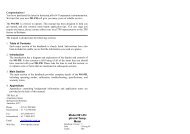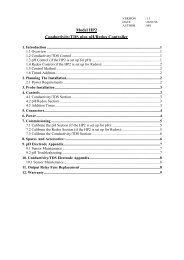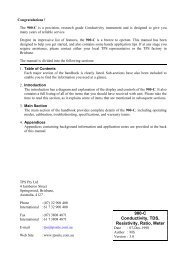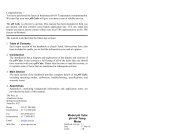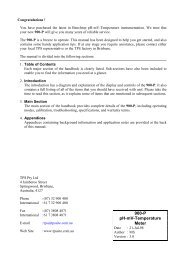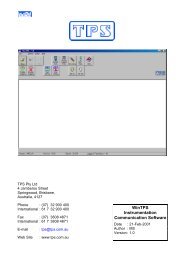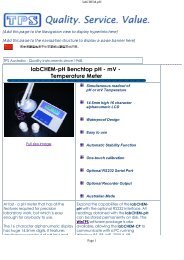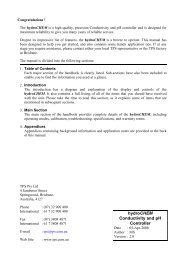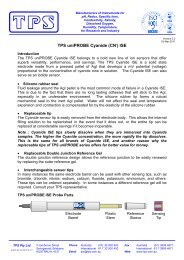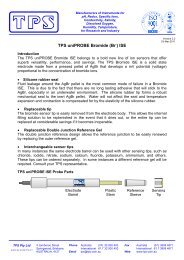Model MC-80 pH-mV-Temp. Meter - TPS
Model MC-80 pH-mV-Temp. Meter - TPS
Model MC-80 pH-mV-Temp. Meter - TPS
Create successful ePaper yourself
Turn your PDF publications into a flip-book with our unique Google optimized e-Paper software.
Congratulations !You have purchased the latest in Handheld <strong>pH</strong>-<strong>mV</strong>-<strong>Temp</strong>eratureinstrumentation. We trust that your new <strong>MC</strong>-<strong>80</strong> will give you manyyears of reliable service.The <strong>MC</strong>-<strong>80</strong> is a breeze to operate. This manual has been designed tohelp you get started, and also contains some handy application tips. Ifat any stage you require assistance, please contact either your local<strong>TPS</strong> representative or the <strong>TPS</strong> factory in Brisbane.The manual is divided into the following sections:1. Table of ContentsEach major section of the handbook is clearly listed. Sub-sections have alsobeen included to enable you to find the information you need at a glance.2. IntroductionThe introduction has a diagram and explanation of the display and controlsof the <strong>MC</strong>-<strong>80</strong>. It also contains a full listing of all of the items that youshould have received with your <strong>MC</strong>-<strong>80</strong>. Please take the time to read thissection, as it explains some of items that are mentioned in subsequentsections.3. Main SectionThe main section of the handbook provides complete details of the<strong>MC</strong>-<strong>80</strong>, including operating modes, calibration, troubleshooting,specifications, and warranty terms.4. AppendicesAppendices containing background information and application notes areprovided at the back of this manual.<strong>TPS</strong> Pty Ltd4 Jamberoo StreetSpringwood, Brisbane,Australia, 4127Phone : (07) 32 900 400International : 61 7 32 900 400Fax : (07) 3<strong>80</strong>8 4871International : 61 7 3<strong>80</strong>8 4871<strong>Model</strong> <strong>MC</strong>-<strong>80</strong><strong>pH</strong>-<strong>mV</strong>-<strong>Temp</strong>.<strong>Meter</strong>Handbook Version : 2.0Date : 30/4/96Author: MS
ContentsPage 11. Introduction.................................................................................................. 21.1 <strong>MC</strong>-<strong>80</strong> Display and Controls................................................................................21.2 Unpacking Information........................................................................................41.3 Specifications ......................................................................................................42. Operating Modes.......................................................................................... 52.1 Display Modes.....................................................................................................52.2 Readout Modes....................................................................................................53. <strong>pH</strong> Calibration .............................................................................................. 73.1 Calibration...........................................................................................................73.2 Calibration Notes.................................................................................................83.3 Calibration Messages ...........................................................................................84. <strong>mV</strong> Calibration.............................................................................................. 85. <strong>Temp</strong>erature Calibration.............................................................................. 95.1 <strong>Temp</strong>erature Calibration ......................................................................................95.2 Calibration Notes.................................................................................................95.3 Calibration Messages ...........................................................................................95.4 Manual <strong>Temp</strong>erature Setting ..............................................................................106. Battery Saver Function .............................................................................. 107. Selecting <strong>pH</strong>6.88 or <strong>pH</strong>7.00 as the Primary Buffer ................................... 108. Initialising the <strong>MC</strong>-<strong>80</strong> ................................................................................. 119. Troubleshooting......................................................................................... 129.1 General Error Messages .....................................................................................129.2 <strong>pH</strong> and <strong>mV</strong> Troubleshooting..............................................................................139.3 <strong>Temp</strong>erature Troubleshooting ............................................................................1410. Warranty ................................................................................................... 1511. Appendices .............................................................................................. 1711.1 <strong>pH</strong> Electrode Fundamentals..............................................................................1711.2 Checking the reference junction of a <strong>pH</strong> electrode. ...........................................1911.3 Determining if an instrument or electrode is faulty............................................2011.4 Instrument software version number.................................................................20
Page 21. Introduction1.1 <strong>MC</strong>-<strong>80</strong> Display and Controls1234567
Page 31 Display16 character alpha-numeric display. Shows <strong>pH</strong>/<strong>mV</strong> and temperaturesimultaneously. A unique “Large Digit” mode nearly doubles the size ofthe digits. See section 2.1.User-friendly prompts and error messages are also provided.234Used to calibrate <strong>pH</strong> and temperature, and to set manual temperaturecompensation value when temperature probe is unplugged. See sections3.1, 5.1, and 5.4.Also used to select <strong>pH</strong>6.88 or <strong>pH</strong>7.00 as the primary buffer. See section 7.Switches between <strong>pH</strong>, <strong>mV</strong> and <strong>Temp</strong>erature modes. See section 2.2.Switches the <strong>MC</strong>-<strong>80</strong> on and off.Hold this key for 3 seconds to invoke the Battery Saver mode. See section 6.5 and 6These keys toggle the <strong>MC</strong>-<strong>80</strong> between Large Display mode and DualDisplay mode. See section 2.1.NOTE: The digits in Large Display mode are made by combining thetwo rows of the display. The result is a small gapapproximately half way up the digits.The and keys are also used to set the manual temperaturecompensation value if the temperature probe is unplugged. See section5.4.7The <strong>TPS</strong> logo. Your guarantee of Technology, Precision and Service, inelectrochemistry.
Page 41.2 Unpacking InformationBefore using your new <strong>MC</strong>-<strong>80</strong>, please check that the following accessories havebeen included:Part No1. <strong>MC</strong>-<strong>80</strong> <strong>pH</strong>-<strong>mV</strong>-<strong>Temp</strong>erature Instrument 1211082. Combination <strong>pH</strong> Electrode 1212073. <strong>Temp</strong>erature/ATC Probe 1212654. <strong>pH</strong>6.88 Buffer, 200mL 1213065. <strong>pH</strong>4.00 Buffer, 200mL 1213816. 9V Battery 1300267. <strong>MC</strong>-<strong>80</strong> Handbook 130050Options that may have been ordered with your <strong>MC</strong>-<strong>80</strong>:1. NiCad Rechargeable battery and charger 1300072. Hard Plastic Carry Case 1300571.3 SpecificationsRanges: 0 to 14.00 <strong>pH</strong>0 to ±1500 <strong>mV</strong>-10.0 to +120.0 o CResolution: 0.01 <strong>pH</strong>1 <strong>mV</strong>0.1 o CAccuracy: ±0.01 <strong>pH</strong>±1 <strong>mV</strong>±0.2 o CInput Impedance : >3 x 10 12 ΩAsymmetry Range : -1.00 to 1.00 <strong>pH</strong>Slope Range : 85.0 to 105.0%<strong>Temp</strong>erature Compensation: 0 to 100.0 o C, automatic or manualPower: 9V Alkaline Battery for 100 hours operation.Optional NiCad battery/charger pack available.Dimensions: 157 x 78 x 35 mmMass : Instrument only : Approx 200gFull Kit : Approx 1.5kgEnvironment <strong>Temp</strong>erature : 0 to 45 o CHumidity : 0 to 90 % R.H.
2. Operating Modes2.1 Display ModesThe <strong>MC</strong>-<strong>80</strong> has two display modes:1. Dual Display mode2. Large Display mode.Press the or keys to toggle between these two modes.Page 52.2 Readout ModesPress the key to roll through the three readout modes.In Dual Display mode, the three readout modes are:1. <strong>pH</strong>Displays <strong>pH</strong> and <strong>Temp</strong>erature readings simultaneously.eg : 7.00<strong>pH</strong>25.0 o cIf the temperature probe is unplugged, the manual temperature setting isdisplayed with 1 o C resolution.eg: 7.00<strong>pH</strong>25 o c2. <strong>mV</strong>Displays <strong>mV</strong> and <strong>Temp</strong>erature readings simultaneously.eg: 1000<strong>mV</strong>25.0 o cIf the temperature probe is unplugged, the manual temperature setting is NOTdisplayed.eg: 1000<strong>mV</strong>Note: <strong>Temp</strong>erature compensation does not apply in <strong>mV</strong> mode.3. <strong>Temp</strong>eratureDisplays just the temperature reading.eg: 25.0 o cIf the temperature probe is unplugged, the manual temperature setting isdisplayed with 1 o C resolution.eg: 25 o c
Page 6In Large Display mode, the three readout modes are:1. <strong>pH</strong>Displays just the <strong>pH</strong> reading in large digits.2. <strong>mV</strong>Displays just the <strong>mV</strong> reading in large digits.3. <strong>Temp</strong>eratureDisplays just the temperature reading in large digits. If the temperature probeis unplugged, the manual temperature setting is displayed with 1 o C resolution.Note:The decimal point is replaced by a ∗ if a <strong>pH</strong> or <strong>Temp</strong>eraturecalibration has failed (see sections 3.1, Calibration and 5.1,<strong>Temp</strong>erature Calibration), if the unit is initialised (see section 8),or if the unit has lost its factory calibration (see section 9.1).
3. <strong>pH</strong> Calibration3.1 CalibrationPage 71. Press the key if the meter is not already switched on.2. Press the key until the meter is in <strong>pH</strong> mode. (See section 2.2, ReadoutModes)3. Plug the <strong>pH</strong> electrode into the Sensor socket and the temperature probe intothe <strong>Temp</strong> socket.4. Ensure that temperature has already been calibrated, or manually set (seesections 5.1 and 5.4). NOTE: If the decimal point in the temperature readingis replaced by a ∗, then the temperature readout is not calibrated.5. Remove the wetting cap from the <strong>pH</strong> electrode.6. Rinse the <strong>pH</strong> and <strong>Temp</strong>erature electrodes in distilled water and blot them dry.7. Ensure that you are using the primary buffer for which the <strong>MC</strong>-<strong>80</strong> has beenset (See section 7, Selecting <strong>pH</strong>6.88 or <strong>pH</strong>7.00 as the Primary Buffer).Place both electrodes into a small sample of <strong>pH</strong>6.88 (or <strong>pH</strong>7.00) buffer, sothat the bulb and reference junction are both covered. DO NOT place theelectrodes directly into the buffer bottle. Discard the used buffer after use.8. When the reading has stabilised, press and hold the key for 2 seconds tocalibrate. If a 1 point calibration has been performed, the ∗ will not beremoved until a full 2 point calibration has been performed.9. Rinse the <strong>pH</strong> and <strong>Temp</strong>erature electrodes in distilled water and blot them dry.10. Place both electrodes into a small sample of <strong>pH</strong>4.00 or <strong>pH</strong>9.23 Buffer, so thatthe bulb and reference junction are both covered. DO NOT place theelectrodes directly into the buffer bottle. Discard the used buffer after use.NOTE: <strong>pH</strong>9.23 buffer is highly unstable. Avoid using this buffer ifpossible. Discard immediately after use.When the reading has stabilised, press and hold the key for 2 seconds tocalibrate. The ∗ will now be replaced by a decimal point, if calibration wassuccessful.11. The <strong>MC</strong>-<strong>80</strong> is calibrated and ready for use.
Page 83.2 Calibration Notes1. A 1-point calibration should be performed at least weekly. In applicationswhere the electrode junction can become blocked, such as dairy products,mining slurries etc, a 1-point calibration may have to be done daily.2. A full 2-point calibration should be performed at least monthly. Of course,more frequent calibration will result in greater confidence in results.3. All calibration information is retained in memory when the <strong>MC</strong>-<strong>80</strong> isswitched off, even when the battery is removed.4. The <strong>MC</strong>-<strong>80</strong> displays the value of the <strong>pH</strong> buffer that it has attempted torecognise at calibration. Ensure that the buffer value displayed corresponds tothe buffer that you are using.3.3 Calibration Messages1. If a 1-point calibration has been successfully performed, the <strong>MC</strong>-<strong>80</strong> willdisplay the following message, and then display the asymmetry of theelectrode.eg: 1 Point then: Asy6.88 OK 0.10 <strong>pH</strong>2. If a 1-point calibration has failed, the <strong>MC</strong>-<strong>80</strong> will display the followingmessage, then the failed asymmetry value of the electrode.eg: 1 Point then: Asy Hi or: Asy Lo6.88Fail 1.50 <strong>pH</strong> -1.50 <strong>pH</strong>3. If a 2-point calibration has been successfully performed, the <strong>MC</strong>-<strong>80</strong> willdisplay the following message, and then the asymmetry and slope of theelectrode.eg: 2 Point then: Asy then: Slope4.00 OK 0.10 <strong>pH</strong> 95.0%4. If a 2-point calibration has failed, the <strong>MC</strong>-<strong>80</strong> will display the followingmessage, and then the failed slope value of the electrode.eg: 2 Point then: Slope Hi or: Slope Lo then: Check4.00Fail 130.0% 70.0% Buffers4. <strong>mV</strong> CalibrationThe <strong>mV</strong> section is factory calibrated. There is no user-calibration facility for thismode.
Page 95. <strong>Temp</strong>erature CalibrationThe temperature readout must be calibrated or manually set before attempting <strong>pH</strong>calibration. The decimal point is replaced by a ∗ if the reading is not calibrated.5.1 <strong>Temp</strong>erature Calibration1. Press the key if the meter is not already switched on.2. Press the key until the meter is in <strong>Temp</strong>erature mode.3. Plug the temperature probe (Part No 121265) into the <strong>Temp</strong> socket.4. Place the probe into a beaker of room temperature water, alongside a goodquality mercury thermometer. Stir the probe and the thermometer gently toensure an even temperature throughout the beaker.5. When the reading has stabilised, press and hold the key for 2 seconds.6. The reading from the probe is now displayed on the top line, and the valueyou are going to set is on the bottom line.eg:25∗0 o C26.07. Press the and keys until the bottom line shows the same temperatureas the mercury thermometer.8. Press the key to calibrate the temperature readout.Alternatively, press the key to abort temperature calibration.9. Note: <strong>Temp</strong>erature calibration information is stored in memory when themeter is switched off, even if the battery is removed. <strong>Temp</strong>erature does notneed to be recalibrated unless the temperature probe is replaced.5.2 Calibration Notes1. <strong>Temp</strong>erature calibration information is stored in memory when the meter isswitched off, even if the battery is removed.2. <strong>Temp</strong>erature does not need to be recalibrated unless the <strong>Temp</strong>erature probe isreplaced or the meter is initialised.5.3 Calibration Messages1. If a temperature calibration has been successfully performed, the <strong>MC</strong>-<strong>80</strong> willdisplay the following message and then the offset value of the probe.eg: <strong>Temp</strong> then: OffsetCal. OK 1.0 o C2. If a temperature calibration has failed, the <strong>MC</strong>-<strong>80</strong> will display the followingmessage, and then the failed offset value of the probe.eg: <strong>Temp</strong> then: OffsetCal.Fail 10.5 o C
Page 105.4 Manual <strong>Temp</strong>erature Setting1. Press the key if the meter is not already switched on.2. Press the key until the meter is in <strong>Temp</strong>erature mode.3. Manual temperature setting is only available if the temperature probe is notplugged in.4. Press and hold the key for 2 seconds.5. The display should now look like this:Man.<strong>Temp</strong>25.06. Press the and keys until the bottom line shows the temperature whichyou wish to set. This value should be the same as the temperature of thesolution you are measuring.Press the key to set the temperature.Alternatively, press the key to abort manual temperature setting.6. Battery Saver FunctionThe <strong>MC</strong>-<strong>80</strong> is equipped with a battery saver function. If no button has beenpressed for five minutes, the unit beeps and flashes the display for 20 seconds,and then shuts off. This function can be disabled for continuous use.To enable or disable the battery saver function:1. Press the key if the meter is not already switched on.2. With the meter already switched on, press and HOLD the key for3 seconds.3. The display should now look like this:Either: :ON or: :OFF9.00V 9.00V4. In this mode, use the or keys to toggle the battery saver function on oroff.NOTE: The display also shows the battery volts. This gives the operator anidea of how much battery life is remaining. The symbol flashes when thebattery volts drops below 7.50 volts. At 6.00 volts the meter turns itself off.5. When you have set the battery saver function to the desired position, press thekey to return to normal measurement mode. The setting is kept in memorywhen the meter is switched off, even if the battery is removed.7. Selecting <strong>pH</strong>6.88 or <strong>pH</strong>7.00 as the Primary BufferThe <strong>MC</strong>-<strong>80</strong> is factory set to automatically recognise <strong>pH</strong>6.88 as the primarybuffer. However, some users may prefer to use <strong>pH</strong>7.00. The following proceduredescribes how to alternate between <strong>pH</strong>6.88 and <strong>pH</strong>7.00 as the primary buffer.1. Switch the meter OFF with the key.
Page 112. Press and HOLD the key while switching the meter back on.3. Release the key when the message, “Select Buffer” is displayed.4. The display will now show the currently selected primary buffer.Use the or keys to alternate between <strong>pH</strong>6.88 and <strong>pH</strong>7.00 buffers.5. Press the key to exit when the desired buffer has been selected. Thesetting is kept in memory when the meter is switched off, even if the battery isremoved. The primary buffer is re-set to <strong>pH</strong>6.88 during initialisation.Note: <strong>pH</strong>6.88 buffer is a DIN 19266 and NBS Primary-standard <strong>pH</strong> solution.Its use is highly recommended for the most accurate possible results. If<strong>pH</strong>7.00 buffer is used, ensure that it is manufactured to 0.01<strong>pH</strong>accuracy. <strong>pH</strong>7.00 buffer has a buffer capacity less than half that of<strong>pH</strong>6.88 buffer and is therefore much less stable.8. Initialising the <strong>MC</strong>-<strong>80</strong>If the calibration settings of the <strong>MC</strong>-<strong>80</strong> exceed the allowable limits, the unit mayneed to be initialised to factory default values. This action may be required if theelectrode is replaced.To initialise the <strong>MC</strong>-<strong>80</strong>:1. Switch the <strong>MC</strong>-<strong>80</strong> off, by pressing the key.2. Press and hold the key while switching the <strong>MC</strong>-<strong>80</strong> the on with thekey.3. The following messages should be displayed:Memory then: You MUST then: <strong>TPS</strong> <strong>MC</strong><strong>80</strong>Reset ! Re-Cal. <strong>pH</strong> <strong>mV</strong> o c4. The meter then displays <strong>pH</strong> and <strong>Temp</strong>erature. Note that the decimal pointshave been replaced with a ∗, to indicate that the unit requires recalibration.Note: When the <strong>MC</strong>-<strong>80</strong> is initialised, the primary buffer value is re-set to<strong>pH</strong>6.88. See section 7 if you wish to select <strong>pH</strong>7.00 buffer.
Page 129. Troubleshooting9.1 General Error MessagesError Message Possible Causes RemedyFactoryCal. FailSeeHandbookThe EEPROM chip whichcontains the factory calibrationinformation has failed.The unit must be returned to<strong>TPS</strong> for service.• <strong>mV</strong> & <strong>Temp</strong>erature readingsmay be up to 10% incorrect.• <strong>pH</strong> readings will be accurateafter a 2-point calibration (usemanual temperatureMemoryFailedCalib.LostMemoryReset !You MUSTRe-Cal.<strong>Meter</strong> displays theword OFF, andswitches off.<strong>Meter</strong> will not turnon.Flashingsymbol.User calibration settings havebeen lost or corrupted.Battery is below 6.00 volts.Battery is exhausted.Battery is below 7.50 volts.compensation).Re-calibrate the instrument. Afull 2-point calibration will berequired for <strong>pH</strong> (see section3.1) and a 1 point calibration fortemperature (see section 5.1).Replace the battery.Replace the battery.Replace the battery. Note thatthe unit will switch itself offwhen the battery falls below6.00 volts.
9.2 <strong>pH</strong> and <strong>mV</strong> TroubleshootingSymptom Possible Causes RemedyUnit fails tocalibrate, even withnew probe.Calibration settings outside ofallowable limits due to previousfailed calibration.1 Point calibrationfails (Asymmetry isgreater than +/-1.00<strong>pH</strong>).2 Point calibrationfails (Slope is lessthan 85.0%).Unstable readings.Continued next page...1. Reference junction blocked.2. Reference electrolytecontaminated.1. Incorrect primary buffer.2. Glass bulb not clean.3. Electrode is aged.4. Connector is damp.5. Buffers are inaccurate.1. Reference junction blocked.2. Glass bulb not clean.3. Bubble in glass bulb.4. Faulty connection to meter.5. Reference junction notimmersed.6. KCl crystals aroundreference junction, insidethe electrolyte chamber.Initialise the unit. See section 8,Initialising the <strong>MC</strong>-<strong>80</strong>.Clean reference junction, as perinstructions supplied with theelectrode.Flush with distilled water andreplace electrolyte.Ensure that you are using theprimary buffer which the<strong>MC</strong>-<strong>80</strong> has been set (Seesection 7, Selecting <strong>pH</strong>6.88 or<strong>pH</strong>7.00 as the Primary Buffer)Clean glass bulb as perinstructions supplied with theelectrode.Attempt rejuvenation, as perinstructions supplied with theelectrode. If not successful,replace electrode.Dry in a warm place.Replace buffers.Clean reference junction, as perinstructions supplied with theelectrode.Clean glass bulb as perinstructions supplied with theelectrode.Flick the electrode to removebubble.Check connectors. Replace ifnecessary.Ensure that the bulb AND thereference junction are fullyimmersed.Rinse electrolyte chamber withwarm distilled water untildissolved. Replace electrolyte.Page 13
Page 14<strong>pH</strong> and <strong>mV</strong> Troubleshooting, continued...Inaccurate readings, Reference junction blocked.even whencalibration issuccessful.Displays 7.00 for allsolutions.Displays 4-5 <strong>pH</strong> forall solutions.Electrical short in connector.Glass bulb or internal stemcracked.9.3 <strong>Temp</strong>erature TroubleshootingClean reference junction, as perinstructions supplied with theelectrode.1. Check connector. Replace ifnecessary.2. Replace electrode.Replace electrode.Symptom Possible Causes RemedyDisplays “Man”when temperatureprobe is plugged in.1. Incorrect temperature probe.2. Faulty temperature probe.Fit new temperature probe, partnumber 121265.<strong>Temp</strong>eratureinaccurate andcannot becalibrated.1. Faulty connector.2. Faulty temperature probe.Check the connector andreplace if necessary.Fit new temperature probe, partnumber 121265.
10. WarrantyPage 15<strong>TPS</strong> Pty. Ltd. guarantees all instruments and electrodes to be free from defects inmaterial and workmanship when subjected to normal use and service. Thisguarantee is expressly limited to the servicing and/or adjustment of an instrumentreturned to the Factory, or Authorised Service Station, freight prepaid, withintwelve (12) months from the date of delivery, and to the repairing, replacing, oradjusting of parts which upon inspection are found to be defective. Warrantyperiod on electrodes is three (3) months.There are no express or implied warranties which extend beyond the face hereof,and <strong>TPS</strong> Pty. Ltd. is not liable for any incidental or consequential damagesarising from the use or misuse of this equipment, or from interpretation ofinformation derived from the equipment.Shipping damage is not covered by this warranty.PLEASE NOTE:A guarantee card is packed with the instrument or electrode. This card must becompleted at the time of purchase and the registration section returned to <strong>TPS</strong>Pty. Ltd. within 7 days. No claims will be recognised without the originalguarantee card or other proof of purchase. This warranty becomes invalid ifmodifications or repairs are attempted by unauthorised persons, or the serialnumber is missing.PROCEDURE FOR SERVICEIf you feel that this equipment is in need of repair, please re-read the manual.Sometimes, instruments are received for "repair" in perfect working order. Thiscan occur where batteries simply require replacement or re-charging, or wherethe electrode simply requires cleaning or replacement.<strong>TPS</strong> Pty. Ltd. has a fine reputation for prompt and efficient service. In just a fewdays, our factory service engineers and technicians will examine and repair yourequipment to your full satisfaction.To obtain this service, please follow this procedure:Return the instrument AND ALL SENSORS to <strong>TPS</strong> freight pre-paid and insuredin its original packing or suitable equivalent. INSIST on a proof of deliveryreceipt from the carrier for your protection in the case of shipping claims fortransit loss or damage. It is your responsibility as the sender to ensure that <strong>TPS</strong>receives the unit.
Page 16Please check that the following is enclosed with your equipment:• Your Name and daytime phone number.• Your company name, ORDER number, and return street address.• A description of the fault. (Please be SPECIFIC.)(Note: "Please Repair" does NOT describe a fault.)• either $13.50 for return freight for units under warranty,or $24 to cover inspection costs and return freight.(These amounts are not applicable to full-account customers.)Your equipment will be repaired and returned to you by air express wherepossible.For out-of-warranty units, a repair cost will be calculated from parts and laborcosts. If payment is not received for the additional charges within 30 days, or ifyou decline to have the equipment repaired, the complete unit will be returned toyou freight paid, not repaired. For full-account customers, the repair charges willbe debited to your account.• Always describe the fault in writing.• Always return the sensors with the meter.
11. Appendices11.1 <strong>pH</strong> Electrode FundamentalsPage 17A combination <strong>pH</strong> Electrode is two electrodes in one. The sensing membrane isthe round or spear shaped bulb at the tip of the electrode. This produces a voltagethat changes with the <strong>pH</strong> of the Solution. This voltage is measured with respectto the second part of the electrode, the reference section. The reference sectionmakes contact with the sample solution using a salt bridge, which is referred to asthe reference junction. A saturated solution of KCl is used to make contact withthe sample. It is vital that the KCl solution has an adequate flow rate in order toobtain stable, accurate <strong>pH</strong> measurements.11.1.1 Asymmetry of a <strong>pH</strong> ElectrodeAn “ideal” <strong>pH</strong> electrode produces 0 <strong>mV</strong> output at 7.00 <strong>pH</strong>. In practise, <strong>pH</strong>electrodes, generally produce 0 <strong>mV</strong> output at slightly above or below 7.00 <strong>pH</strong>.The amount of variance from 7.00 <strong>pH</strong> is called the asymmetry. Figure 11-1illustrates how asymmetry is expressed.Electrode Response (<strong>mV</strong>)6004002000-200-400Response of <strong>pH</strong> Electrode, as a Function of Asymmetry+1.00 <strong>pH</strong> Asymmetry0.00 <strong>pH</strong> Asymmetry-1.00 <strong>pH</strong> Asymmetry-6000 7 14<strong>pH</strong>Figure 11-1
Page 1811.1.2 The Slope of a <strong>pH</strong> ElectrodeAs mentioned above, a <strong>pH</strong> electrode produces 0 <strong>mV</strong> output at around 7.00 <strong>pH</strong>.As the <strong>pH</strong> goes up, an “ideal” <strong>pH</strong> electrode produces -59<strong>mV</strong>/<strong>pH</strong> unit at 25 o C Asthe <strong>pH</strong> goes down, an ideal <strong>pH</strong> electrode produces +59<strong>mV</strong>/<strong>pH</strong> unit. In practice,<strong>pH</strong> electrodes usually produce slightly less than this. The output of a <strong>pH</strong>electrode is expressed as a percentage of an ideal electrode. For example, an idealelectrode that produces 59<strong>mV</strong>/<strong>pH</strong> unit has “100% Slope”. An electrode thatproduces 50.15<strong>mV</strong>/<strong>pH</strong> unit has “85% Slope” (see Figure 11-2).Electrode Response (<strong>mV</strong>)6004002000-200-400Response of <strong>pH</strong> Electrode, as a Function of Slope85% Slope at 25 oC(50.15<strong>mV</strong>/<strong>pH</strong>)100% Slope at 25 oC(59<strong>mV</strong>/<strong>pH</strong>)-6000 7 14<strong>pH</strong>Figure 11-2
11.1.3 <strong>Temp</strong>erature CompensationThe slope of a <strong>pH</strong> electrode (section 11.1.2) is affected by temperature. Thiseffect is compensated for either by using an Automatic <strong>Temp</strong>eratureCompensation (ATC) probe or by entering the sample temperature manually.Figure 11-3 shows the slope of a <strong>pH</strong> electrode at various temperatures.Electrode Response (<strong>mV</strong>)6004002000-200-400<strong>pH</strong> Electrode Response, as a Function of <strong>Temp</strong>erature-6000 7 14<strong>pH</strong>Figure 11-3ElectrodePotential (<strong>mV</strong>) at0 oC (54<strong>mV</strong>/<strong>pH</strong>)ElectrodePotential (<strong>mV</strong>) at50 oC (64<strong>mV</strong>/<strong>pH</strong>)ElectrodePotential (<strong>mV</strong>) at100 oC (74<strong>mV</strong>/<strong>pH</strong>)Page 1911.2 Checking the reference junction of a <strong>pH</strong> electrode.If <strong>pH</strong> readings are inaccurate or unstable, the reference junction of the electrodemay be blocked. The following test can be performed to determine if thereference junction of a <strong>pH</strong> electrode is making adequate contact with the samplesolution.1. Calibrate the <strong>MC</strong>-<strong>80</strong>, as per section 3.1.2. Dilute 1 part of <strong>pH</strong>6.88 buffer with 9 parts of distilled water.3. Measure the <strong>pH</strong> of the diluted buffer. The result should be 7.06 +/-0.02 <strong>pH</strong>.4. If the value obtained is outside of these limits, then clean the referencejunction, as per the instructions supplied with the <strong>pH</strong> electrode.5. Re-calibrate the <strong>MC</strong>-<strong>80</strong> and repeat the test.6. If the value obtained is still outside 7.06 +/-0.02 <strong>pH</strong>, then the electrode shouldbe replaced.
Page 2011.3 Determining if an instrument or electrode is faultyThe following test can be performed to help determine if the <strong>MC</strong>-<strong>80</strong> or the <strong>pH</strong>electrode is faulty.1. Initialise the <strong>MC</strong>-<strong>80</strong> (see section 8, Initialising the <strong>MC</strong>-<strong>80</strong>).2. Disconnect the <strong>pH</strong> electrode.3. Connect the centre pin of the Sensor connector with the outside frame of theconnector, using a short piece of wire or a paper clip etc.4. The meter should read approximately 7.00. If you press the key, the<strong>MC</strong>-<strong>80</strong> will calibrate to around 6.88 <strong>pH</strong>, depending upon the temperaturereadout.5. If the <strong>MC</strong>-<strong>80</strong> is operating correctly, the reading should be totally stable withthe wire firmly in place. If not, the meter requires servicing.6. Now carefully disconnect the wire from the centre pin only (make sure theother end of the wire remains connected to the outside frame of theconnector).7. The reading should steadily drift away from 7.00 (either up or down) at a rateof approximately 1 <strong>pH</strong> or less every 3 seconds. If the drift rate is faster thanthis, then input circuitry of the <strong>MC</strong>-<strong>80</strong> is faulty and requires servicing.11.4 Instrument software version number.If you need to phone or fax <strong>TPS</strong> for any further technical assistance, the versionnumber of your <strong>MC</strong>-<strong>80</strong> firmware may of benefit to us. Please obtain the versionnumber as follows, before phoning or faxing:1. Switch the <strong>MC</strong>-<strong>80</strong> on by pressing the key.2. While the model is being displayed, press the key.3. The unit will now display the model and version number,eg: <strong>TPS</strong> <strong>MC</strong><strong>80</strong>Ver 2.0



